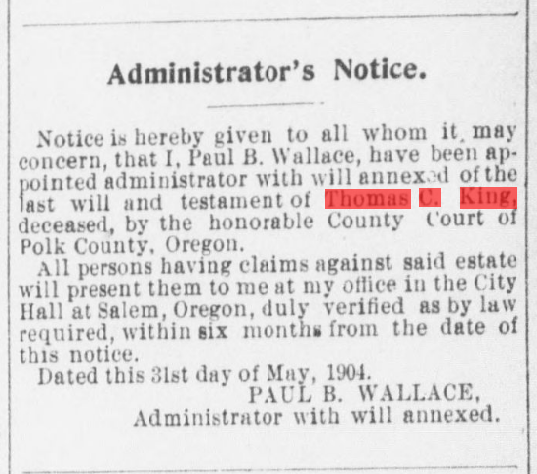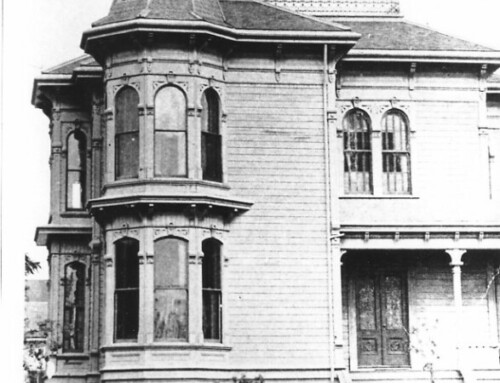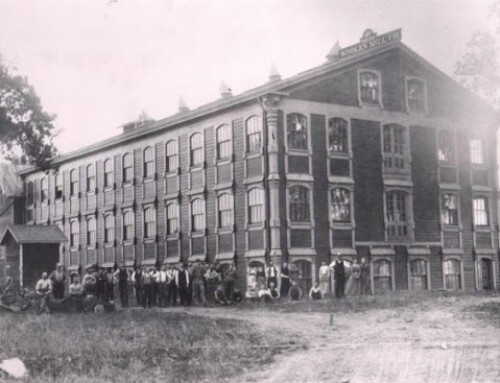In the archives of Salem photographer Myra Sperry’s portraits at the State Library of Oregon, there is full-length portrait of an African American man in a dapper three-piece suit, one hand resting on a small table.[1] His elaborate cravat, watch chain and pocket square are identical to another portrait held by the Oregon Historical Society. This second portrait provides a name and a date: T.C. King, 1893.[2] While a picture might be worth a thousand words, they weren’t very forthcoming. Instead, it took many hours and some really lucky breaks to unravel some of the details behind Mr. King’s life.
T.C. King is almost certainly Thomas “Tom” C. King, who died in Polk County[3] on March 5, 1904from a valvular hear issue, at least according to his obituaries and Marion County death certificate.[4] Neither of these sources are particularly helpful in describing King’s early life. His death certificate lists his age as “50 or more”[5] and one obituary states “he was born in Tennessee or Kentucky.”[6] They are a little more effusive about his later life, describing him as a: “man who for so many years held a responsible position on the big Wallace farm. He was intelligent and thoroughly upright, and a valuable hand wherever placed. He has prospered in the past few years, and has been looking after work and business of his own. He has a timber tract in Tillamook County, having only just recently returned from there. His friends think that possibly the unusual exertion of his trip may have been responsible for the attack which caused his untimely death. All who know Tom remember him with pleasure, and his death will cause a feeling of regret among his many friends.”[7]
The Wallace farm was the West Salem summer residence and fruit farm of the Robert S. Wallace family. The name may ring a bell to anyone who has recently driven on Wallace Road in West Salem. Much of what was the Wallace farm is now the Salemtowne community.[8] Hints in newspaper articles suggest that Mr. King worked as a driver (of the horse and carriage/horse and wagon variety) for the family, both for passengers and boxes of fruit sent for processing at Salem canneries.[9] One of the more memorable documented trip he made included driving members of the “Atollo Club” hosted by Mrs. Wallace in June 1895. As the Oregon Statesman described: “Rah, rah, rah!.. Atollo! Atollo! Ha ha ha! This yell, together with many shouts and laughter rang out through the streets of Salem on last Tuesday evening, attracting the attention of passers-by to a happy group of “Atolloites,” forty-six in number perched in every conceivable position on a well-cushioned hay rack with T.C. King at the reins.”[10]
What brought King to Oregon may be an unsolvable mystery, but we do know from newspaper accounts that he seems to have arrived by July of 1891, when he is listed as representing Kentucky at a “States Picnic” held to welcome newcomers to the city.[11] Bits and pieces from newspaper accounts, like the winning of a drawing for a blanket from the Salem Woolen Mills store[12] and his representation of Salem Presbyterians to a Christian Endeavor Conference[13] provide some clues to what his life may have been like in Salem. It is hard not to draw conclusions, though, from his decision to relocate to Tacoma in 1897[14] and Portland in 1898,[15] that Salem may not have been as welcoming a place as other entries might make it seem.
The timber tract mentioned as the potential cause of death in his obituaries was 160 acres of land in Tillamook County just north of the community of Beaver. Today the property is part of the Tillamook State Forest. [16]
Luckily for historians researching him, King had the foresight of having a will made before his death. The will is probably the most thorough documentation of his life, and was key to unlocking more clues of his early experiences. The will and probate documents have a complete itemized list of his possessions, and outstanding bills at the time of his death. The two suits of clothing and watch connect with what we can see in the photographs. His team of horses, 6 cords of wood, 15 bushels of grass seed, 9 bushels of hay and stand of bees speak to his agricultural endeavors and skill. And maybe most heart breaking: “The shepherd dog appraised as belonging to the…estate ran away and was never found.”[17] Couple that last piece of information with a notice he filed in the paper for a lost dog in 1896,[18] and the photograph of a dog that takes pride of place in his own portrait[19] suggests he was likely a dog person.
The will also lists the names of King’s mother (Sarah King), sisters (Lizzie Lewis, Lulu Samson and Maggie Cavanaugh) and niece (Lulu Lewis) as his heirs and their addresses in Nicholsville, Kentucky and Indianapolis, Indiana.[20] While the will is amazingly helpful in identifying clues about King’s early life, it is also clear from this document that he was very, very far from his family, which by the time of his death had mostly moved away from the addresses he had listed in the document.[21] It is unclear from the court reports if news of his death or residuals of his estate ever made it back to these heirs, or if he ever got word of his mother’s death just a few years before his own.
Another chance application filled out at the Freedman’s Savings and Trust Company in Lexington, Kentucky on August 28, 1871 helped to fill out a few more details about King’s early life. The application lists King’s parents’ names and all 10 of his siblings including the three sisters listed on his will. At the time he filled out the application, he was living in Lexington and working as a sexton. The application states he was born in Jessamine County, Kentucky in about 1847.
It is very likely [22]that Thomas King was one of the 3614 enslaved individuals of African heritage in Jessamine County, Kentucky enumerated in the 1860 Slave schedule of the U.S. Federal Census, which unfortunately did not list individuals by name, just by age, gender and race.[23]
While there is a four-year age difference and four-mile discrepancy between counties of birth, the enlistment record of a 21-year old Thomas King to Company D of the 12th Regiment U.S. Colored Heavy Artillery at Camp Nelson, Kentucky in 1864 seems like a plausible fit, although there is not enough in the document itself to prove it is the same individual with certainty.[24] Camp Nelson, just outside of Nicholsville, which was where almost all of Thomas C. King’s heirs are listed as living in his will, was a Union Army installation. Active efforts were made there to recruit Black men to become soldiers in the Union Army, offering a practical pathway to emancipation for enslaved people in Kentucky who had been explicitly left out of those freed by the statements in the Emancipation Proclamation.[25] [26] The Thomas King in the enlistment record served for over two years as a private. The enlistment record also holds another potential clue about his early life, reporting that he was enslaved by a David Logan.[27]
There are a number of Kings who enlisted at Camp Nelson, including what could possibly be Thomas King’s father (Milo – a fairly uncommon name)[28] and three of his brothers (William, James, John – more common names).[29] It is interesting to note that James King, died while serving and is buried at the Camp Nelson National Cemetery.[30] It is also interesting to note that in the enlistment records, Milo, James, Thomas and John all have different men listed as their enslavers, potentially giving insight into how the family may have been forced to live apart early on.[31]
My mind continues to go back to the photograph of a woman on the table next to Mr. King’s hand in his portrait at the State Library. Was the photograph a prop in the photo studio, or a treasured memento of a mother, sister, or niece back east? Might the woman in the photo help explain the undocumented 20+ years between the end of the Civil War and his drastic move to Oregon? As always, more questions are raised than answers found in the research process. Even with their mysteries, the portraits provide one of the few monuments to Thomas C. King’s life. Buried at Salem’s City View Cemetery, his final resting place has no marker.[32]
[1] Photograph State library of Oregon Catalog number: 2007.001.0295-6 State Library of Oregon Catalog
[2] Photograph. Oregon Historical Society. Sperry the Artist 1893 (0192G012) Cronise Collection
[3] “Tom King Dead” Oregon Statesman 06 March 1904 pg 4 (Newspapers.com) Died at the Schindler place in Polk County, two or three miles below Salem, On Friday March 4th. Yes, despite the Marion County death certificate!!!
[4] DEATH CERTIFICATE Marion County 493 (Ancestry.com)
[5] DEATH CERTIFICATE Marion County 493 (Ancestry.com)
[6] “Tom King Dead” Oregon Statesman 06 March 1904 pg 4 (Newspapers.com)
[7] “Dropped dead.” Capital Journal 05 March 1904 pg 5 (Newspapers.com)
[8] Reference the 1929 Metsker’s Map which shows the R.S. Wallace Orchard Co. In place; Much, Justin. “History of Wallace Family on Display.” Statesman Journal 21 Feb 2010 pg 19 (Newspapers.com);
[9] “Royal Anns” Weekly Oregon Statesman 12 July 1895 pg 3 (newspapers.com) . T.C. King of “The Willows” the Wallace Fruit farm—brought a full wagon load of Royal Ann Cherries to the Salem cannery yesterday for which he received 4 cents per pound.
“Thomas C. King.” Sunday Oregonian, March 6, 1904 pg 7 (Historic Oregon Newspapers)
Salem, Or. March 5. (Special) Thomas C. King, a colored man, well known here as the coachman for the Wallace family, died today of heart disease.; “An evening at ‘the willows’” Oregon Statesman 30 June 1895 pg 5 (Newspapers.com)
[10] “An evening at ‘the willows’” Oregon Statesman 30 June 1895 pg 5 (Newspapers.com)
[11] “The States Picnic” Capital Journal 06 Jul 1891 pg 1 (Newspapers.com)
Salemites did not “celebrate” the 4th of July this year, but she laid herself out to make the people of a large area happy….The attraction was what has been termed a “states picnic” which was held in the refreshing groves of the State Fair grounds. About 10,000 people participated…The prime object of this novel project was to extend a hearty welcome to the thousands of newcomers in our midst, and while the effort was a modest one and to some extent an experiment, it must be declared a success….People from every state in the union were provided with comfortable headquarters bearing the name of their state on a large banner. Here they gathered for social intercourse. A book was given for all to register, giving their former residence and date of leaving for Oregon. After registration they were supplied with neat silk badges to pin on their garments, bearing the name of their state and the following words: “States Picnic, Salem, Or, July 4th 1891.” This badge made it possible for the wearers to recognize others from their former homes, and many found opportunity to revive old recollections of a very pleasant character…. Pg 4 – Kentucky….T.C. King
[12] “Got the Blankets” Oregon Statesman 16 May 1893 pg 1 (Newspapers.com)
The drawing of the blankets at the Woolen Mill Store resulted in coupon number 681, this ticket being held by T.C. King of the Wallace fruit farm; “Personal and Local.” Capital Journal 16 May 1893 pg 4 (Newspapers.com)
…The blankets given away at the Woolen Mill store resulted in coupon number 681, this ticket being held by T.C. King of the Wallace fruit farm.
[13] “C.E Convention.” Oregon Statesman11 May 1895 pg 3 (Newspapers.com)
Listing delegates from the Presbyterian faith to the Christian Endeavor (C.E.) Conference in Oregon…
T.C. King……Salem.
Clara E. Pooler, Salem
P.H. Raymond, Salem
[14] “Personals.” Oregon Statesman 01 Oct 1897 pg 1 (Newspapers.com)
Tom King, who for years has been a valued employe [sic] of the late R.S. Wallace and his family, leaves today to take up a permanent residence at Tacoma.; “Oregon Personals” Capital Journal 01 Oct 1897 pg 6 (Newspapers.com) T.C. King left today for Tacoma, where he will locate.
[15] Salem Society Notes.” Capital Journal 26 Sept 1898 pg 3 (Newspapers.com)
Tom King, formerly of “the Willows” Salem, and now of Portland is busy greeting friends in this city.
[16] 1902 Land Assessment Ledger (Familysearch) -Description of land HD SW NE, N ½, SE AND SW SE Section 19 3 S 9 W 160 acres. 10 dollars Thomas C. King; “Contest Notice” Tillamook Headlight 11 March 1909 pg 5 (Historic Oregon Newspapers)
Department of the Interior, US land office, Portland, Oregon February 26, 1909
A sufficient contest affidavit having been filed in this office by GEORGE VANDERSEE, contestant, against homestead entry No. 14164, made June 3, 1902 for SW ¼, NE 1/4 , N ½, SE ¼, and SW ¼, SE ¼ section 19 Township 3 south, range 9 west by Thomas C. King, contestee, in which it is alleged that he is well acquainted with the tract of land embraced in the homestead entry and knows the present condition of the same; also that the said Thomas C. King died near Salem, Oregon, on or about March 1904; that said Thomas C. King, according to the best knowledge and belief of affiant, was, at the time of his death, a single man, and that he has no knowledge of such heirs, except that he has been informed that at the time of the death of said King, two or three brothers survived him, and that said brothers reside in some of the Southern States; but affiant has not been able to learn any or either of the names of said brothers nor of their residence or post office address, that between the time of making entry upon said lands and the death of said King, the said King did not cultivate or improve said lands according to the law and that since his said death and up to the present time the heirs of said King have not in anywise resided upon, cultivated or improved the said lands, or any part therof to any extend whatever; and that to the best knowledge and belief of affiant said alleged absence from the said land was not due to his or their employment in the Army, Navy or Marine Corps of the United States, as a private solder [sic], officer, seaman or marine, during any war in which the United States might have been engaged.
Said parties are hereby notified to appear, respond or offer evidence touching said allegation at 10 o’clock am on April 12th 1909 before W.H. cooper, U.S. Commissioner, at his office at Tillamook City, Oregon and that final hearing will be held at 10 o’clock am on April 22nd 1909, before the Register and Receiver at the United State Land Office in Portland, Oregon……; 1974 Metsker’s Map shows ownership by State of Oregon. (Source HistoricMapWorks); Currently under ownership of Oregon Department of Forestry and classified as part of the Tillamook State Forest: https://maps.dsl.state.or.us/slis/ (State Land Inventory System provided information)
[17] Polk County Probate Files (Accessed via Ancestry.com)
[18] “New Today” Oregon Statesman 06 Aug 1896 pg 4 (Newspapers.com)
Lost. On Wednesday between Salem and the Wallace fruit farms, a valuable bird dog, 8 months old. The dog is brown in color and has a strap around his neck. Finder please return to T.C. King at the “willows”
[19] Photograph State library of Oregon Catalog number: 2007.001.0295-6 State Library of Oregon Catalog
[20] Polk County Probate Files (Accessed via Ancestry.com)
[21] The 1900 US Federal Census shows Sarah/Sadie King living with daughters Maggie and Lizzie in Indianapolis. 1900 US FEDERAL CENSUS (Ancestry.com) Indianapolis, Marion, Indiana 1313 Yanders Street
[22] Based on the potential find of an enlistment record which lists an enslaver’s name (which name Thomas King is likely common and may not be him) and what we know is very like Thomas C. King’s father, Milo King’s military records which describe Milo as a “slave recruit.” See notations below.
[23] 1860 US Census, Slave Schedules.
[24] US Colored Troops Service Records (Ancestry.com)
Thomas King
Company D, 12th Regiment US Colored H. Artillery
Age 21, height 5 foot 6 inches
Black Complexion, black eyes, black hair
Born Lincoln Co., Kentucky
Farmer
Enlisted 25 July 1864
Camp Nelson by J.C. Rudolph for 3 year term
Note: Most of the other records state Thomas C. King was born in 1847, by these records Private King was born in 1843. The enlistment record states Private King was born in Lincoln County, Kentucky, most other records for Thomas C. King say Jessamine County, Kentucky. Note that the muster records credit enlistment to Jessamine County, Kentucky.
[25] Kentucky has a complicated Civil War History. Technically Kentucky was a slave state that remained in the union. The Emancipation proclamation only freed enslaved people in the territories that were in open rebellion with the Union. (Read text of the Emancipation Proclamation here: https://www.archives.gov/exhibits/featured-documents/emancipation-proclamation/transcript.html). Read more about the exclusion of enslaved people from the action of the Empancipation Proclamation here: Kentucky’s Abraham Lincoln. Kentucky Historical Society. Accessed 2/28/2024. https://apps.legislature.ky.gov/LegislativeMoments/moments09RS/web/Lincoln%20moments%2024.pdf. ”On 22 September, five days after the Union victory at Antietam, Lincoln issued his Preliminary Emancipation Proclamation. It declared “henceforth and forever free” all slaves in those states still in rebellion as of January 1, 1863. Though the final proclamation explicitly excluded the enslaved population of Kentucky, the political and social ramifications were immediate and explosive.”
[26] History of Camp Nelson, now a National Monument: https://www.nps.gov/cane/index.htm
[27] US Colored Troops Service Records (Ancestry.com)
Thomas King Company D, 12th Regiment US Colored H. Artillery
[28] 1864 Descriptive Lists of Colored Volunteer Army Soldiers (Ancestry.com)
Milow King, Private, aged 40, Occupation: Farmer, Birth about 1825, Jessamine, Kentucky. Note he is listed as 5’9” tall, Enlisted Slave recruit. “Name of owner: Polly Neal.”; US Colored Troops Military Service Records (Ancestry.com)
Milow King, 40, Private/Private est. year of birth c. 1825 Military Date 1865, 119th US Colored infantry, Company G. Infantry; US Civil War Soldiers (Ancestry.com) Melow King, Union, US Colored Troops, 119th Regiment, US Colored Infantry Company G. Private, Part of African American Civil War Memorial, Plaque D-122 Melow King
[29] William’s Records: United States Colored Troops Records (Ancestry.com)
William King, Private Co. K 12 Regt US Colored H. Art’y (same regiment at potentially Thomas King); James’ Records: Descriptive list of Colored Volunteers (Ancestry.com)
James King, Enslaver: James Hill. Jessamine County, Kentucky Enlisted July 1, 1864Mustered July 5, 1864, Camp Nelson, Kentucky. John’s Records: US Colored Troops Military Service Records (Ancestry.com)
John King, Company K 6 Regiment US Colored Cavalry
Age 19, 5’6” Complexion Brown, Eyes, Black, Hair Black
Enlisted May 24, 1865, Camp Nelson
By Jas Pwell, Term of 3 years
Mustered May 24, 1865 William Goodloe at Lexington
Roll Dated Lexington Ky, May 25, 1865
Born Jessamine County, KY
Aged 19 years, Occupation Farmer
Enlisted May 24, Where Credited: Jessamine Co. Kentucky
Remarks: Owner Jim Logan
[30] Burial Register Camp Nelson National Cemetery (Ancestry.com)
King, James, Private. Company I, 124th US Colored Troops Infantry, DOD August 27 , 1865
Section B 262 / 640; February Death Date (Interment Control Form Ancestry); US Find-a-Grave (Ancestry.com)
[31] See notes above for enlistment records details. Milo King, enslaved by Polly Neal; James King enslaved by James Hill; Thomas King enslaved by David Logan. John King enslaved by Jim Logan.
[32] Probate Records show purchase of lot in City View Cemetery: Polk County Probate Records (Ancestry.com)–J.D. Bohannon – 7 space on lot 3 in block 36 Section A in City View Cemetery, digging of grave $10.00; Corroborated by Death Certificate: DEATH CERTIFICATE Marion County 493 (Ancestry.com); Personal visit to the cemetery by author and discussion with staff led me to the unmarked spot with a map and guidance from extant headstones.

Announcement in the Polk County Observer, July 7, 1922, page 4. Accessed via the Oregon Digital Newspaper Project. July 7, 1922
More information: Contact the Willamette Heritage Center for a full biography with citations and notations.







This is so interesting to me- I had a great, great grandfather, Thomas King, who also moved to Salem in a similar time frame! Small world, even centuries ago.